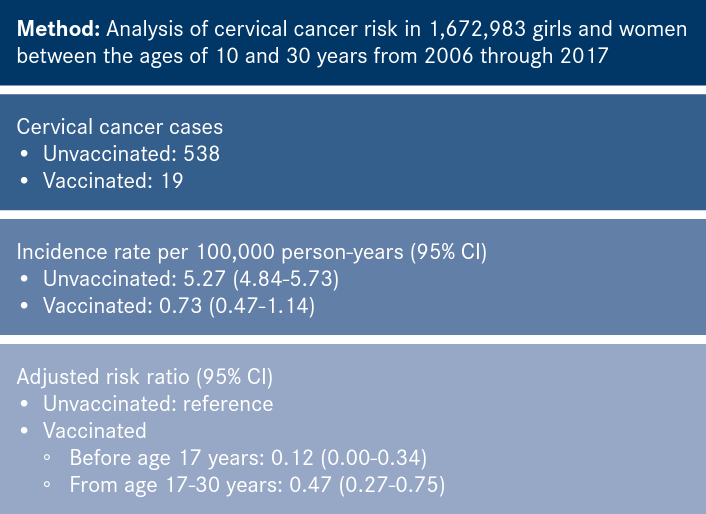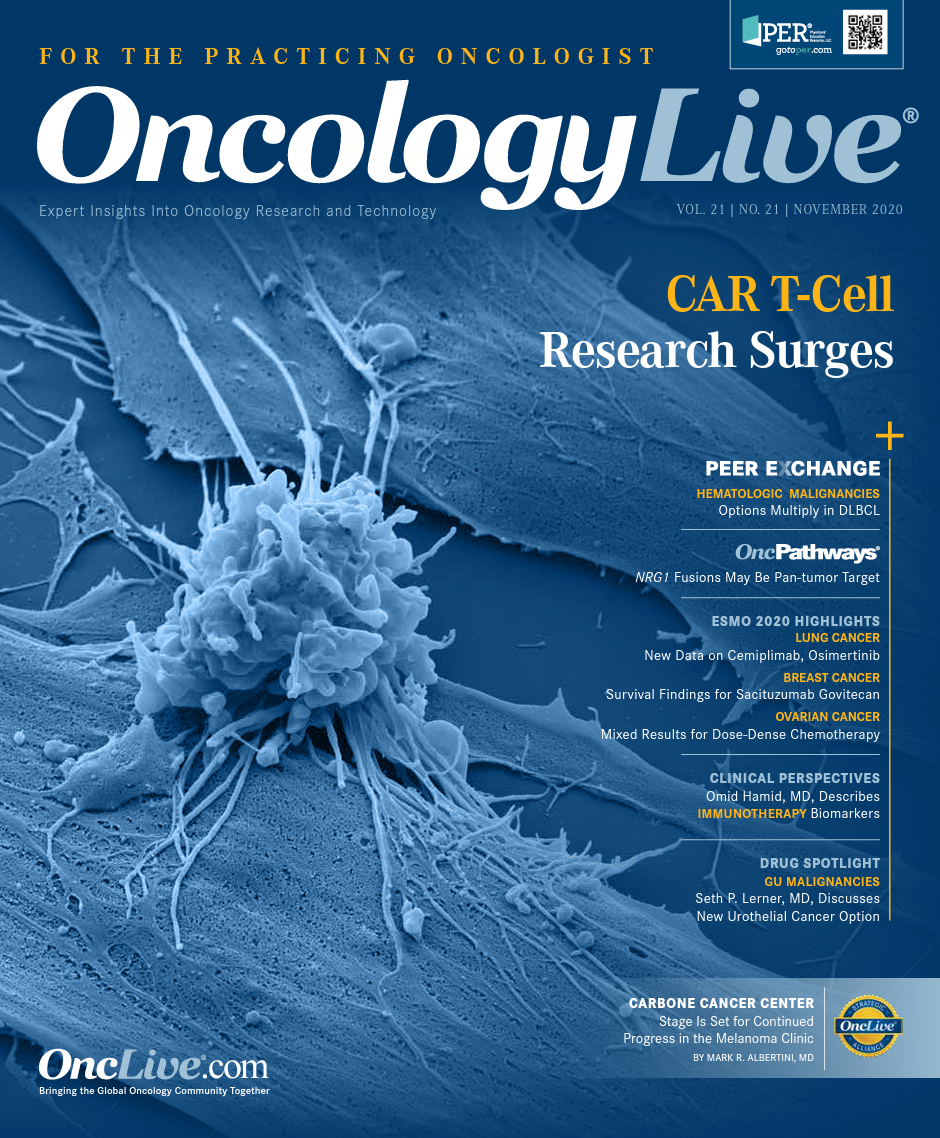Publication
Article
Oncology Live®
HPV Vaccination Is a Battle That Must Be Won
Author(s):
Despite solid evidence that human papillomavirus vaccination is remarkably effective in preventing persistent infection by HPV types that are known to be responsible for more than 70% to 80% of cervical cancer cases worldwide, this strategy’s utility in substantially reducing the subsequent development of the malignancy itself remained an open question.
Cervical Cancer

Despite solid evidence that human papillomavirus (HPV) vaccination is remarkably effective in preventing persistent infection by HPV types that are known to be responsible for more than 70% to 80% of cervical cancer cases worldwide, this strategy’s utility in substantially reducing the subsequent development of the malignancy itself remained an open question.1 Now, the results are in, confirming the major impact of this cancer prevention strategy.
A landmark population-based study in Sweden followed 1,672,983 females aged 10 to 30 years from 2006 to 2017 to evaluate HPV vaccination’s effect on their risk of developing invasive cervical cancer.2 As reported in the New England Journal of Medicine, a total of 19 cases of cervical cancer were diagnosed in women who received HPV vaccination (ie, the quadrivalent vaccine) compared with 538 women who were not vaccinated.2 The patient population was evaluated for the risk of developing cervical cancer until they were age 31. After adjusting for several relevant covariates, the investigators found that the incidence rate ratio for the development of cervical cancer, comparing women who were vaccinated before age 17 with unvaccinated women, was 0.12. For those aged 17 to 30 years, the incidence rate ratio was 0.47 (TABLE2). The authors concluded that “among Swedish girls and women 10 to 30 years old, quadrivalent HPV vaccination was associated with a substantially reduced risk of invasive cervical cancer at the population level.”2
The scope of this truly remarkable public health outcome probably will become even more impressive with the passage of time. Right now, however, we are at a troubling juncture in our efforts to widely employ a relatively simple and highly cost-effective cancer prevention strategy that has the potential to prevent the immense suffering that can result from advanced cervical malignancies.
To date, societal acceptance of HPV vaccination in the United States has had a difficult history. In the early introduction of strategies to routinely vaccinate adolescent girls in the mid-2000s, there was less than optimal communication with parents. There was an unfortunate focus on the fact that HPV is sexually transmitted rather than on the goal of cancer prevention; specifically, to prevent an infection that over time may lead to several very serious malignancies. Further, the HPV vaccine strategy quickly caught the attention of those in the growing worldwide antivaccine movement; the potent misinformation campaign began with the infamous publication from Andrew Wakefield that incorrectly linked common childhood vaccinations with autism.3 The disconcerting impact of the growing refusal to vaccinate for potentially deadly infections such as the measles has been painfully documented.4
Public Distrust Hinders Uptake
Unfortunately, the turmoil within the federal government’s coronavirus disease 2019 (COVID-19) response has exacerbated concerns regarding public health agencies’ ability to effectively communicate a coherent, believable message regarding the effectiveness and safety of a variety of critically important measures.5 In an indication of the magnitude of the distrust of the government’s health-related regulatory environment, the CEOs of 9 pharmaceutical companies working on COVID-19 vaccines felt it necessary to publicly pledge that they would not seek approval of a product unless they felt it had satisfied all necessary requirements for safety and efficacy.6
Table. Key Findings in Swedish HPV Study2
Table. Key Findings in Swedish HPV Study

From the Editor
Long before the COVID-19 pandemic generated public health concerns, uptake of the HPV vaccine was falling short. A 2017-2018 survey of parents or caregivers of 82,297 adolescents (aged 13-17 years) showed that 37.1% of eligible individuals were unvaccinated and 10.8% had received just 1 vaccine dose (of a 2- or 3-dose regimen).7 Despite the unequivocal safety and efficacy of HPV vaccination (and all vaccines approved for routine use in the United States8), almost half of this large adolescent population has not received or completed an approach strongly recommended by all major public health agencies to prevent persistent infection with this cancer-causing virus.
According to the survey results, the most common reason parents failed to agree to vaccinate their children involved concerns regarding safety (22.8%), again emphasizing the failure of public health agencies to effectively communicate with large portions of the population.7 Further, the findings indicate that among the adolescents who initiated HPV vaccination but had no intention of completing the series to ensure adequate protection, the major reason (as reported by parents) was the absence of a health care provider’s recommendation to do so (22.2%).
Findings from another study further emphasize concerns related to the lack of physician recommendations for HPV vaccination. In a group of 955 adolescent cancer survivors (aged 9-26 years) who were between 1 and 5 years post completion of anticancer therapy, the patients or their parents reported that 73% of their providers had failed to recommend that they receive this vaccine. This outcome is quite remarkable, considering both the ages of this population and also the fact that young cancer survivors have an increased risk of developing malignancies associated with persistent HPV infections.9
There is a critical need for the overall health care community, including practicing oncologists, to become directly and purposefully involved in effectively communicating, to both patients and their parents, regarding the societal and individual benefits of HPV vaccination as a safe and highly effective approach to cancer prevention.
References
- Bailey HH, Chuang LT, duPont NC, et al. American Society of Clinical Oncology statement: human papillomavirus vaccination for cancer prevention. J Clin Oncol. 2016; 34(15)1803-1812. doi:10.1200/JCO.2016.67.20142.
- Lei J, Ploner A, Elfström KM, et al. HPV vaccination and the risk of cervical cancer. N Engl J Med. 2020;383(14):1340-1348. doi:10.1056/NEJMoa1917338.3.
- Larson HJ. The biggest pandemic risk? viral misinformation. Nature. 2018;562(7727):309. doi:10.1038/d41586-018-07034-44.
- Zucker JR, Rosen JB, Iwamoto M, et al. Consequences of undervaccination―measles outbreak, New York City, 2018-2019. N Engl Med. 2020;382(11):1009-1017. doi:10.1056/NEJMoa19125145.
- Weiland N, Stolberg SG, Goodnough A. Political appointees meddled in C.D.C.’s virus literature. New York Times. September 13, 2020:A4.W6.
- Biopharma leaders unite to stand with science. News release. Business Wire. September 8, 2020. Accessed October 16, 2020. https://bwnews.pr/37dr0GH7.
- Sonawane K, Zhu Y, Montealegre JR, et al. Parental intent to initiate and complete the human pap-illomavirus vaccine series in the USA: a nationwide, cross-sectional survey. Lancet Public Health. 2020;5(9):e-484-e492. doi:10.1016/S2468-2667(20)30139-08.
- Tau N, Yahav D, Shepshelovich D. Postmarketing safety of vaccines approved by the U.S. Food and Drug Administration: a cohort study. Ann Intern Med. 2020;173(6):445-449. doi:10.7326/M20-27269.
- York JM, Klosky JL, Chen Y, et al. Patient-level factors associated with lack of health care provider recommendation for the human papillomavirus vaccine among young cancer survivors. J Clin Oncol. 2020;38(25):2892-2901. doi:10.1200/JCO.19.02026





























%20(2)%201-Recovered-Recovered-Recovered-Recovered-Recovered-Recovered-Recovered-Recovered-Recovered-Recovered-Recovered-Recovered-Recovered-Recovered-Recovered-Recovered-Recovered.jpg?fit=crop&auto=format)
%20(2)%201-Recovered-Recovered-Recovered-Recovered-Recovered-Recovered-Recovered-Recovered-Recovered-Recovered-Recovered-Recovered-Recovered-Recovered-Recovered-Recovered-Recovered.jpg?fit=crop&auto=format)
